sensor MERCEDES-BENZ R-Class 2012 W251 Owner's Manual
[x] Cancel search | Manufacturer: MERCEDES-BENZ, Model Year: 2012, Model line: R-Class, Model: MERCEDES-BENZ R-Class 2012 W251Pages: 368, PDF Size: 15.19 MB
Page 7 of 368
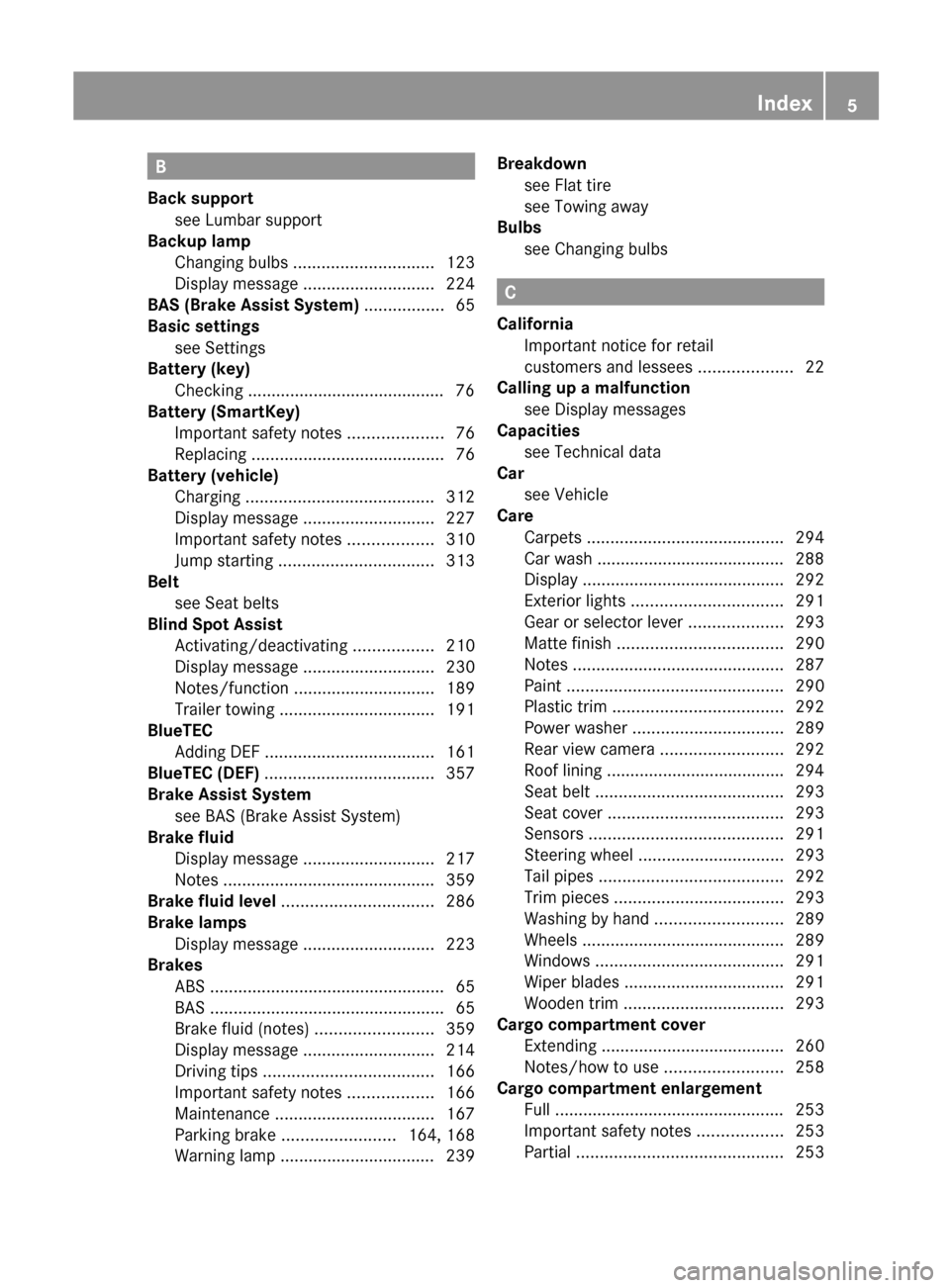
B
Back support see Lumbar support
Backup lamp
Changing bulbs .............................. 123
Display message ............................ 224
BAS (Brake Assist System) ................. 65
Basic settings see Settings
Battery (key)
Checking .......................................... 76
Battery (SmartKey)
Important safety notes ....................76
Replacing ......................................... 76
Battery (vehicle)
Charging ........................................ 312
Display message ............................ 227
Important safety notes ..................310
Jump starting ................................. 313
Belt
see Seat belts
Blind Spot Assist
Activating/deactivating .................210
Display message ............................ 230
Notes/function .............................. 189
Trailer towing ................................. 191
BlueTEC
Adding DEF .................................... 161
BlueTEC (DEF) .................................... 357
Brake Assist System see BAS (Brake Assist System)
Brake fluid
Display message ............................ 217
Notes ............................................. 359
Brake fluid level ................................ 286
Brake lamps Display message ............................ 223
Brakes
ABS .................................................. 65
BAS .................................................. 65
Brake fluid (notes) .........................359
Display message ............................ 214
Driving tips .................................... 166
Important safety notes ..................166
Maintenance .................................. 167
Parking brake ........................ 164, 168
Warning lamp ................................. 239Breakdown
see Flat tire
see Towing away
Bulbs
see Changing bulbs
C
California Important notice for retail
customers and lessees ....................22
Calling up a malfunction
see Display messages
Capacities
see Technical data
Car
see Vehicle
Care
Carpets .......................................... 294
Car wash ........................................ 288
Display ........................................... 292
Exterior lights ................................ 291
Gear or selector lever ....................293
Matte finish ................................... 290
Notes ............................................. 287
Paint .............................................. 290
Plastic trim .................................... 292
Power washer ................................ 289
Rear view camera .......................... 292
Roof lining ...................................... 294
Seat belt ........................................ 293
Seat cover ..................................... 293
Sensors ......................................... 291
Steering wheel ............................... 293
Tail pipes ....................................... 292
Trim pieces .................................... 293
Washing by hand ........................... 289
Wheels ........................................... 289
Windows ........................................ 291
Wiper blades .................................. 291
Wooden trim .................................. 293
Cargo compartment cover
Extending ....................................... 260
Notes/how to use .........................258
Cargo compartment enlargement
Full ................................................. 253
Important safety notes ..................253
Partial ............................................ 253
Index5
Page 13 of 368

Delayed switch-off (on-board
computer) ...................................... 208
Emergency lighting ........................119
Manual control ............................... 119
Overview ........................................ 118
Reading lamp ................................. 118
see Interior lighting
J
Jack Storage location ............................ 296
Using ............................................. 305
Jump starting (engine) ...................... 313
K
Key see SmartKey
KEYLESS-GO
Convenience closing feature ............88
Display message ............................ 236
Locking ............................................ 73
Start/Stop button .......................... 145
Starting the engine ........................147
Unlocking ......................................... 73
Key positions
KEYLESS-GO .................................. 145
SmartKey ....................................... 145
Kickdown ........................................... 153
L
Lamps see Warning and indicator lamps
Lane-change assistant
see Blind Spot Assist
Language (on-board computer) ........ 206
LATCH-type (ISOFIX) child seat
anchors ................................................ 58
Level control (display message) ...... 229
License plate lamp Changing bulbs .............................. 124
Display message ............................ 223
Lighting
see Lights
Lights
Activating/deactivating the
exterior lighting delayed switch-
off .................................................. 207
Activating/deactivating the
interior lighting delayed switch-off . 208
Automatic headlamp mode ............115
Display message ............................ 222
Driving abroad ............................... 114
Fog lamps ...................................... 116
Hazard warning lamps ...................117
High beam flasher .......................... 117
High-beam headlamps ...................117
Light switch ................................... 114
Low-beam headlamps ....................115
Parking lamps ................................ 114
Rear fog lamp ................................ 116
Switching the daytime running
lamps on/off (on-board
computer) ...................................... 206
Switching the daytime running
lamps on/off (switch) ....................115
Switching the surround lighting
on/off (on-board computer) ..........207
Turn signals ................................... 117
see Changing bulbs
see Interior lighting
Light sensor (display message) ....... 225
LIM indicator lamp Cruise control ................................ 171
DISTRONIC .................................... 175
Loading guidelines ............................ 248
Locking see Central locking
Locking (doors)
Automatic ........................................ 80
Emergency locking ........................... 81
From inside (central locking
button) ............................................. 80
Locking centrally
see Central locking
Locking verification signal (on-
board computer) ............................... 208
Low-beam headlamps Changing bulbs .............................. 121
Display message ............................ 222Index11
Page 15 of 368

Convenience submenu ..................209
Displaying a service message ........287
Displaying the coolant
temperature ................................... 202
Displaying the outside
temperature ................................... 202
Display messages ..........................213
DISTRONIC menu .......................... 178
Factory settings ............................. 205
Important safety notes ..................198
Instrument cluster submenu ..........205
Lighting submenu .......................... 206
Menu overview .............................. 201
Message memory menu ................. 213
Navigation menu ............................ 204
Operating video DVD .....................204
Operation ....................................... 199
Selecting the language ..................206
Settings menu ............................... 205
Standard display ............................ 202
Status bar ...................................... 206
Telephone menu ............................ 211
Time/Date submenu .....................206
Trip computer menu ......................210
Vehicle submenu ........................... 208
Opening and closing the side trim
panels ................................................. 123
Operating system see On-board computer
Outside temperature
Calling up (on-board computer) .....202
Display ........................................... 198
Overhead control panel ...................... 34
Override feature Rear side windows ...........................63
P
Paint code number ............................ 353
Paintwork (cleaning instructions) ... 290
Panic alarm .......................................... 64
Panorama roof with power tilt/
sliding panel Opening/closing .............................. 91
Opening/closing the roller
sunblind ........................................... 91
Problem (malfunction) .....................92
Resetting ......................................... 92
Panorama sliding sunroof
Important safety notes ....................89
Parking
Important safety notes ..................163
Parking brake ................................ 164
Position of exterior mirror, front-
passenger side ............................... 111
Rear view camera .......................... 187
see Parking
see PARKTRONIC
Parking aid
see Exterior mirrors
see PARKTRONIC
Parking brake
Display message ............................ 217
Notes/function .............................. 164
see Parking brake
Parking lamps (changing bulbs) ...... 122
PARKTRONIC Deactivating/activating .................186
Driving system ............................... 184
Function/notes ............................. 184
Problem (malfunction) ...................187
Range of the sensors .....................184
Trailer towing ................................. 186
Warning display ............................. 185
Pedals ................................................. 165
Permanent four-wheel drive see 4MATIC (permanent four-
wheel drive)
Plastic trim (cleaning instructions) . 292
Power washers .................................. 289
Power windows see Side windows
PRE-SAFE ®
(Preventive occupant
safety system) Display message ............................ 218
Operation ......................................... 49
PRE-SAFE ®
Brake (vehicles with
DISTRONIC PLUS) Warning lamp ................................. 245
Preventive occupant safety
system
see PRE-SAFE ®
(Preventive
occupant safety system)
Product information ............................ 21
Program selector button .................. 153Index13
Page 16 of 368
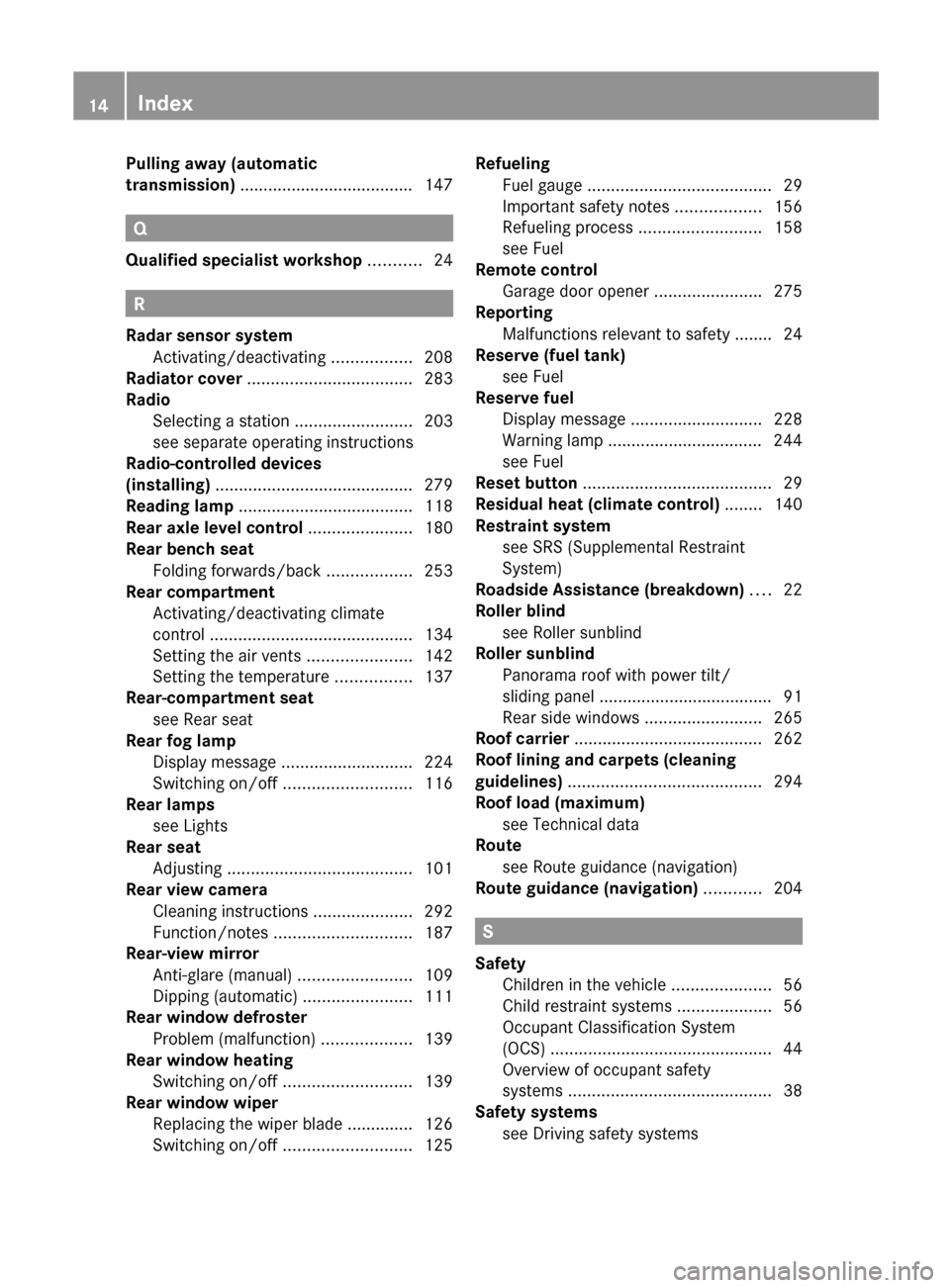
Pulling away (automatic
transmission) ..................................... 147
Q
Qualified specialist workshop ........... 24
R
Radar sensor system Activating/deactivating .................208
Radiator cover ................................... 283
Radio Selecting a station .........................203
see separate operating instructions
Radio-controlled devices
(installing) .......................................... 279
Reading lamp ..................................... 118
Rear axle level control ...................... 180
Rear bench seat Folding forwards/back ..................253
Rear compartment
Activating/deactivating climate
control ........................................... 134
Setting the air vents ......................142
Setting the temperature ................137
Rear-compartment seat
see Rear seat
Rear fog lamp
Display message ............................ 224
Switching on/off ........................... 116
Rear lamps
see Lights
Rear seat
Adjusting ....................................... 101
Rear view camera
Cleaning instructions .....................292
Function/notes ............................. 187
Rear-view mirror
Anti-glare (manual) ........................109
Dipping (automatic) .......................111
Rear window defroster
Problem (malfunction) ...................139
Rear window heating
Switching on/off ........................... 139
Rear window wiper
Replacing the wiper blade .............. 126
Switching on/off ........................... 125
Refueling
Fuel gauge ....................................... 29
Important safety notes ..................156
Refueling process ..........................158
see Fuel
Remote control
Garage door opener .......................275
Reporting
Malfunctions relevant to safety ........ 24
Reserve (fuel tank)
see Fuel
Reserve fuel
Display message ............................ 228
Warning lamp ................................. 244
see Fuel
Reset button ........................................ 29
Residual heat (climate control) ........ 140
Restraint system see SRS (Supplemental Restraint
System)
Roadside Assistance (breakdown) .... 22
Roller blind see Roller sunblind
Roller sunblind
Panorama roof with power tilt/
sliding panel ..................................... 91
Rear side windows .........................265
Roof carrier ........................................ 262
Roof lining and carpets (cleaning
guidelines) ......................................... 294
Roof load (maximum) see Technical data
Route
see Route guidance (navigation)
Route guidance (navigation) ............ 204
S
Safety Children in the vehicle .....................56
Child restraint systems ....................56
Occupant Classification System
(OCS) ............................................... 44
Overview of occupant safety
systems ........................................... 38
Safety systems
see Driving safety systems
14Index
Page 17 of 368
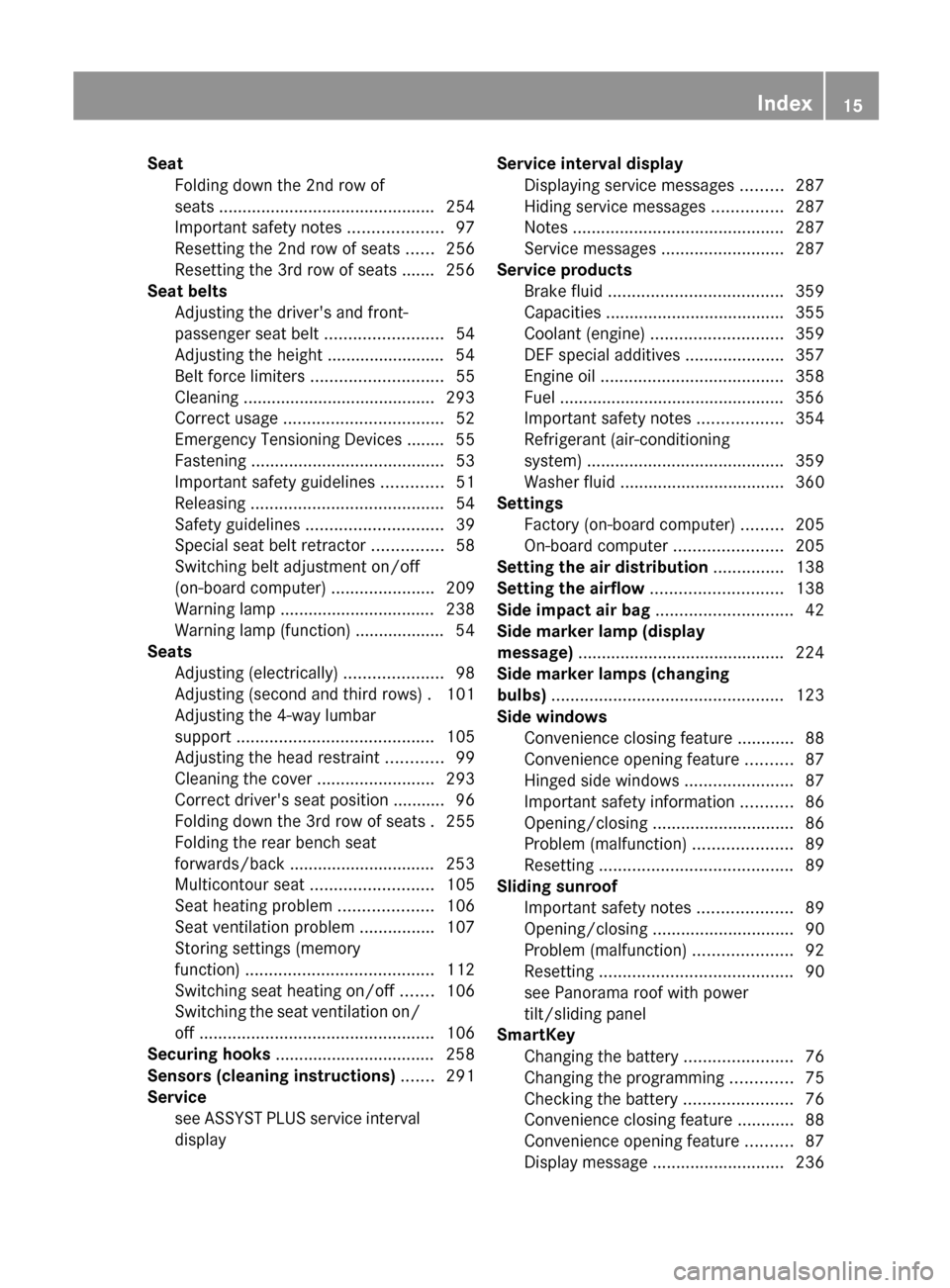
SeatFolding down the 2nd row of
seats .............................................. 254
Important safety notes ....................97
Resetting the 2nd row of seats ......256
Resetting the 3rd row of seats ....... 256
Seat belts
Adjusting the driver's and front-
passenger seat belt .........................54
Adjusting the height ......................... 54
Belt force limiters ............................ 55
Cleaning ......................................... 293
Correct usage .................................. 52
Emergency Tensioning Devices ........ 55
Fastening ......................................... 53
Important safety guidelines .............51
Releasing ......................................... 54
Safety guidelines ............................. 39
Special seat belt retractor ...............58
Switching belt adjustment on/off
(on-board computer) ......................209
Warning lamp ................................. 238
Warning lamp (function) ................... 54
Seats
Adjusting (electrically) .....................98
Adjusting (second and third rows) . 101
Adjusting the 4-way lumbar
support .......................................... 105
Adjusting the head restraint ............99
Cleaning the cover .........................293
Correct driver's seat position ........... 96
Folding down the 3rd row of seats . 255
Folding the rear bench seat
forwards/back ............................... 253
Multicontour seat .......................... 105
Seat heating problem ....................106
Seat ventilation problem ................107
Storing settings (memory
function) ........................................ 112
Switching seat heating on/off .......106
Switching the seat ventilation on/
off .................................................. 106
Securing hooks .................................. 258
Sensors (cleaning instructions) ....... 291
Service see ASSYST PLUS service interval
display Service interval display
Displaying service messages .........287
Hiding service messages ...............287
Notes ............................................. 287
Service messages ..........................287
Service products
Brake fluid ..................................... 359
Capacities ...................................... 355
Coolant (engine) ............................ 359
DEF special additives .....................357
Engine oil ....................................... 358
Fuel ................................................ 356
Important safety notes ..................354
Refrigerant (air-conditioning
system) .......................................... 359
Washer fluid ................................... 360
Settings
Factory (on-board computer) .........205
On-board computer .......................205
Setting the air distribution ............... 138
Setting the airflow ............................ 138
Side impact air bag ............................. 42
Side marker lamp (display
message) ............................................ 224
Side marker lamps (changing
bulbs) ................................................. 123
Side windows Convenience closing feature ............88
Convenience opening feature ..........87
Hinged side windows .......................87
Important safety information ...........86
Opening/closing .............................. 86
Problem (malfunction) .....................89
Resetting ......................................... 89
Sliding sunroof
Important safety notes ....................89
Opening/closing .............................. 90
Problem (malfunction) .....................92
Resetting ......................................... 90
see Panorama roof with power
tilt/sliding panel
SmartKey
Changing the battery .......................76
Changing the programming .............75
Checking the battery .......................76
Convenience closing feature ............88
Convenience opening feature ..........87
Display message ............................ 236Index15
Page 40 of 368
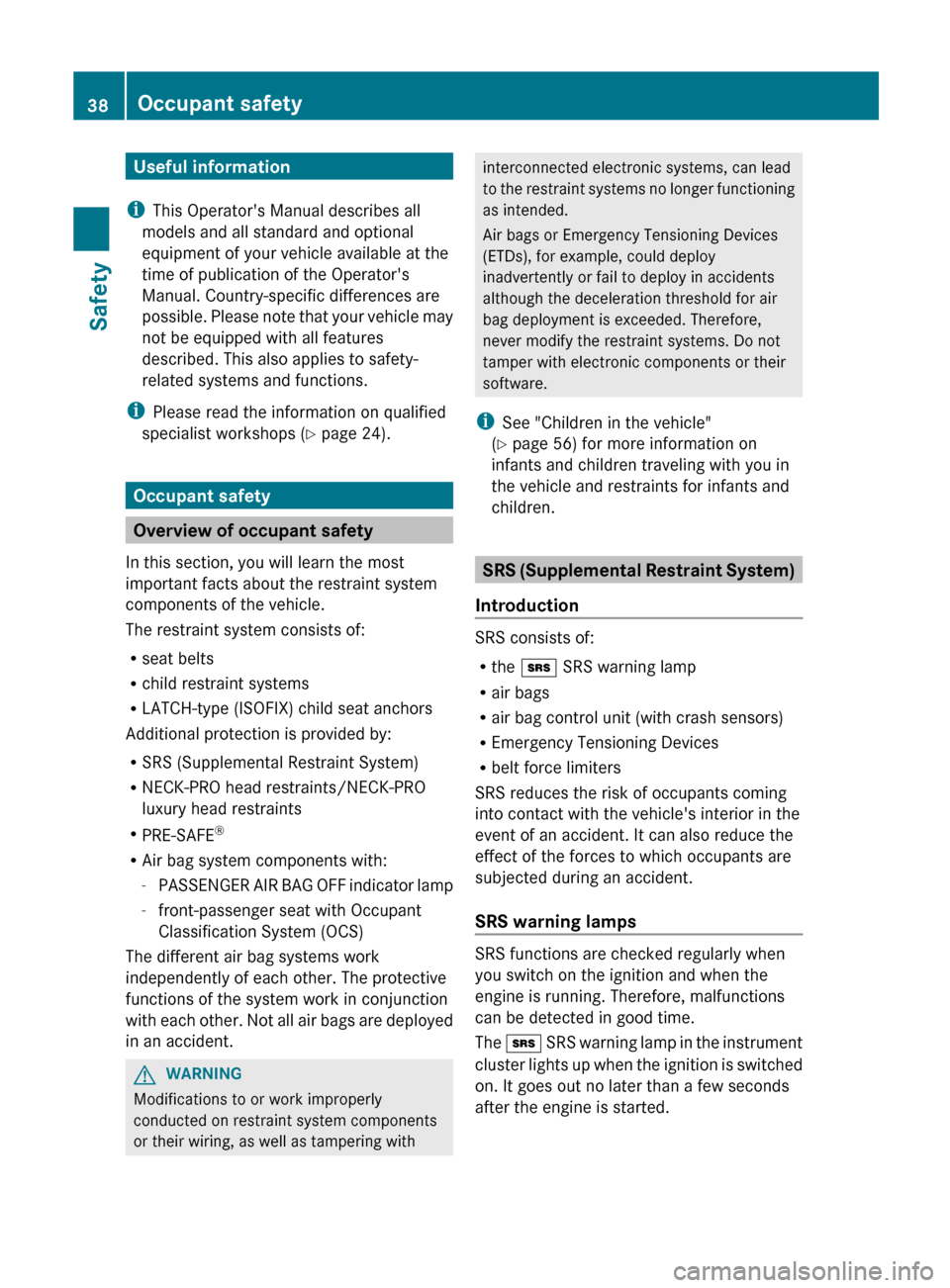
Useful information
i This Operator's Manual describes all
models and all standard and optional
equipment of your vehicle available at the
time of publication of the Operator's
Manual. Country-specific differences are
possible. Please note that your vehicle may
not be equipped with all features
described. This also applies to safety-
related systems and functions.
i Please read the information on qualified
specialist workshops ( Y page 24).
Occupant safety
Overview of occupant safety
In this section, you will learn the most
important facts about the restraint system
components of the vehicle.
The restraint system consists of:
R seat belts
R child restraint systems
R LATCH-type (ISOFIX) child seat anchors
Additional protection is provided by:
R SRS (Supplemental Restraint System)
R NECK-PRO head restraints/NECK-PRO
luxury head restraints
R PRE-SAFE ®
R Air bag system components with:
- PASSENGER AIR BAG OFF indicator lamp
- front-passenger seat with Occupant
Classification System (OCS)
The different air bag systems work
independently of each other. The protective
functions of the system work in conjunction
with each other. Not all air bags are deployed
in an accident.
GWARNING
Modifications to or work improperly
conducted on restraint system components
or their wiring, as well as tampering with
interconnected electronic systems, can lead
to the restraint systems no longer functioning
as intended.
Air bags or Emergency Tensioning Devices
(ETDs), for example, could deploy
inadvertently or fail to deploy in accidents
although the deceleration threshold for air
bag deployment is exceeded. Therefore,
never modify the restraint systems. Do not
tamper with electronic components or their
software.
i See "Children in the vehicle"
( Y page 56) for more information on
infants and children traveling with you in
the vehicle and restraints for infants and
children.
SRS (Supplemental Restraint System)
Introduction
SRS consists of:
R the + SRS warning lamp
R air bags
R air bag control unit (with crash sensors)
R Emergency Tensioning Devices
R belt force limiters
SRS reduces the risk of occupants coming
into contact with the vehicle's interior in the
event of an accident. It can also reduce the
effect of the forces to which occupants are
subjected during an accident.
SRS warning lamps
SRS functions are checked regularly when
you switch on the ignition and when the
engine is running. Therefore, malfunctions
can be detected in good time.
The + SRS warning lamp in the instrument
cluster lights up when the ignition is switched
on. It goes out no later than a few seconds
after the engine is started.
38Occupant safetySafety
Page 44 of 368

It is important for your safety and that of your
passenger to have deployed air bags replaced
and to have any malfunctioning air bags
repaired. This will help to make sure the air
bags continue to perform their protective
function for the vehicle occupants in the
event of a crash.
Front air bags
The front air bags increase protection for the
driver's and front-passenger's head and
chest.
Driver's air bag : deploys in front of the
steering wheel; front-passenger front air
bag ; deploys in front of and above the glove
box.
They are deployed:
R in the event of certain frontal impacts
R if the system determines that air bag
deployment can offer additional protection
to that provided by the seat belt
R if the seat belt is fastened
R independently of other air bags in the
vehicle
If the vehicle overturns, the front air bags are
generally not deployed unless the system
detects high vehicle deceleration in a
longitudinal direction.
Your vehicle has adaptive, two-stage front air
bags. In the event of a collision, the air bag
control unit evaluates the vehicle
deceleration. In the first deployment stage,
the front air bag is filled with enough
propellant gas to reduce the risk of injuries.
The front air bag is fully deployed if a second
deployment threshold is exceeded within a
few milliseconds.
The deployment of the front-passenger front
air bag is also influenced by the weight
category of the front passenger, which is
determined by the Occupant Classification
System (OCS) ( Y page 44).
The lighter the passenger side occupant, the
higher the vehicle deceleration rate required
(predicted at the start of the impact) for
second stage inflation of the front-passenger
front air bag. In the second stage, the front
air bags are inflated with the maximum
amount of propellant gas available.
The front air bags are not deployed in
situations where a low impact severity is
predicted. You will then be protected by the
fastened seat belt.
The front-passenger front air bag will only
deploy if:
R the system, based on the OCS weight
sensor readings, detects that the front-
passenger seat is occupied.
R
R the air bag control unit predicts a high
impact severity.
Side impact air bagsGWARNING
The pressure sensors for side impact air bag
control are located in the doors. Do not
modify any components of the doors or door
trim panels including, for example, the
addition of door speakers.
Improper repair work on the doors or the
modification or addition of components to the
doors create a risk of rendering the side
impact air bags inoperative or causing
unintended air bag deployment. Work on the
doors must therefore only be performed by
qualified technicians. Contact an authorized
Mercedes-Benz Center.
42Occupant safetySafety
Page 46 of 368
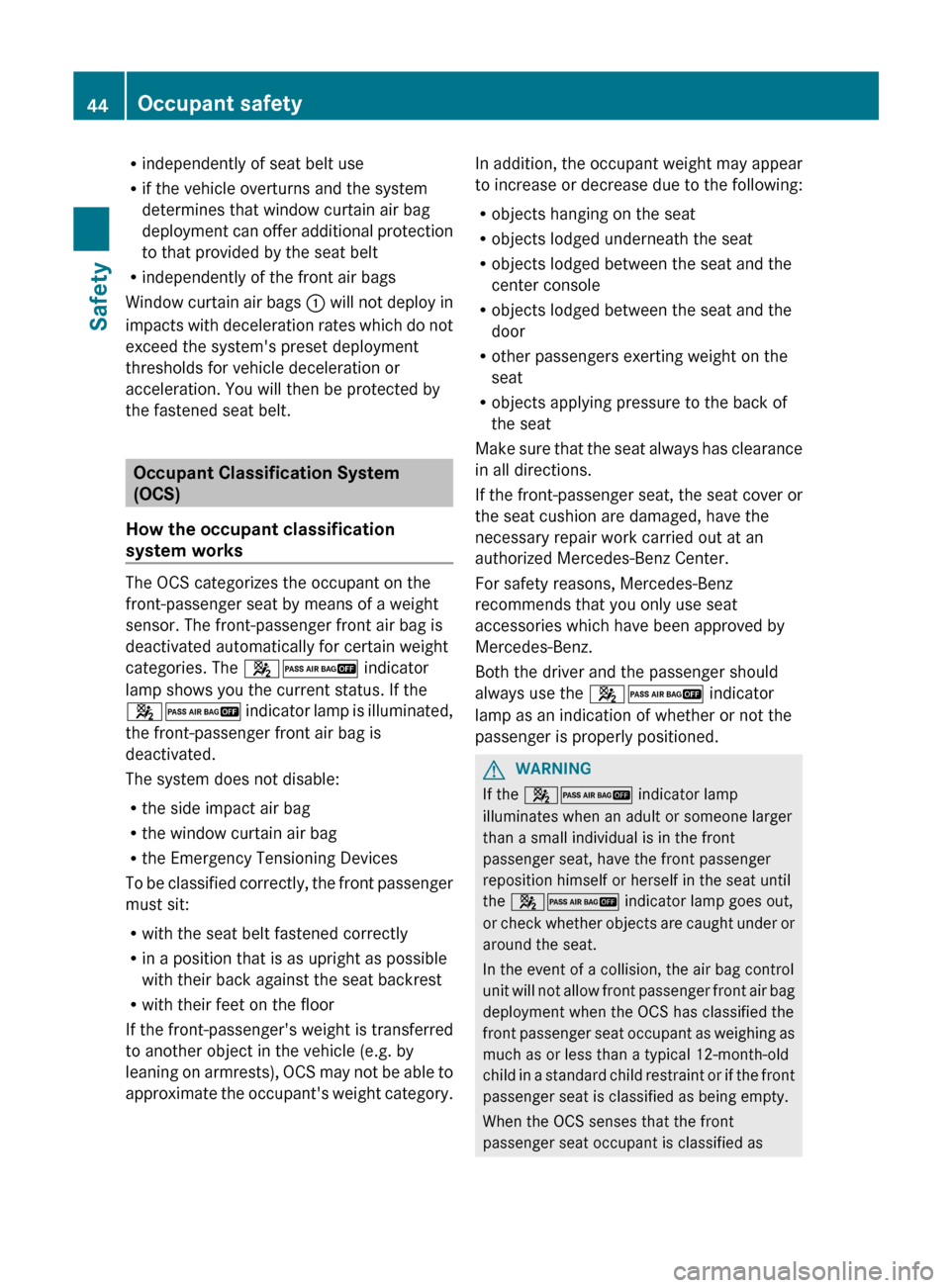
Rindependently of seat belt use
R if the vehicle overturns and the system
determines that window curtain air bag
deployment can offer additional protection
to that provided by the seat belt
R independently of the front air bags
Window curtain air bags : will not deploy in
impacts with deceleration rates which do not
exceed the system's preset deployment
thresholds for vehicle deceleration or
acceleration. You will then be protected by
the fastened seat belt.
Occupant Classification System
(OCS)
How the occupant classification
system works
The OCS categorizes the occupant on the
front-passenger seat by means of a weight
sensor. The front-passenger front air bag is
deactivated automatically for certain weight
categories. The 42 indicator
lamp shows you the current status. If the
42 indicator lamp is illuminated,
the front-passenger front air bag is
deactivated.
The system does not disable:
R the side impact air bag
R the window curtain air bag
R the Emergency Tensioning Devices
To be classified correctly, the front passenger
must sit:
R with the seat belt fastened correctly
R in a position that is as upright as possible
with their back against the seat backrest
R with their feet on the floor
If the front-passenger's weight is transferred
to another object in the vehicle (e.g. by
leaning on armrests), OCS may not be able to
approximate the occupant's weight category.
In addition, the occupant weight may appear
to increase or decrease due to the following:
R objects hanging on the seat
R objects lodged underneath the seat
R objects lodged between the seat and the
center console
R objects lodged between the seat and the
door
R other passengers exerting weight on the
seat
R objects applying pressure to the back of
the seat
Make sure that the seat always has clearance
in all directions.
If the front-passenger seat, the seat cover or
the seat cushion are damaged, have the
necessary repair work carried out at an
authorized Mercedes-Benz Center.
For safety reasons, Mercedes-Benz
recommends that you only use seat
accessories which have been approved by
Mercedes-Benz.
Both the driver and the passenger should
always use the 42 indicator
lamp as an indication of whether or not the
passenger is properly positioned.GWARNING
If the 42 indicator lamp
illuminates when an adult or someone larger
than a small individual is in the front
passenger seat, have the front passenger
reposition himself or herself in the seat until
the 42 indicator lamp goes out,
or check whether objects are caught under or
around the seat.
In the event of a collision, the air bag control
unit will not allow front passenger front air bag
deployment when the OCS has classified the
front passenger seat occupant as weighing as
much as or less than a typical 12-month-old
child in a standard child restraint or if the front
passenger seat is classified as being empty.
When the OCS senses that the front
passenger seat occupant is classified as
44Occupant safetySafety
Page 47 of 368
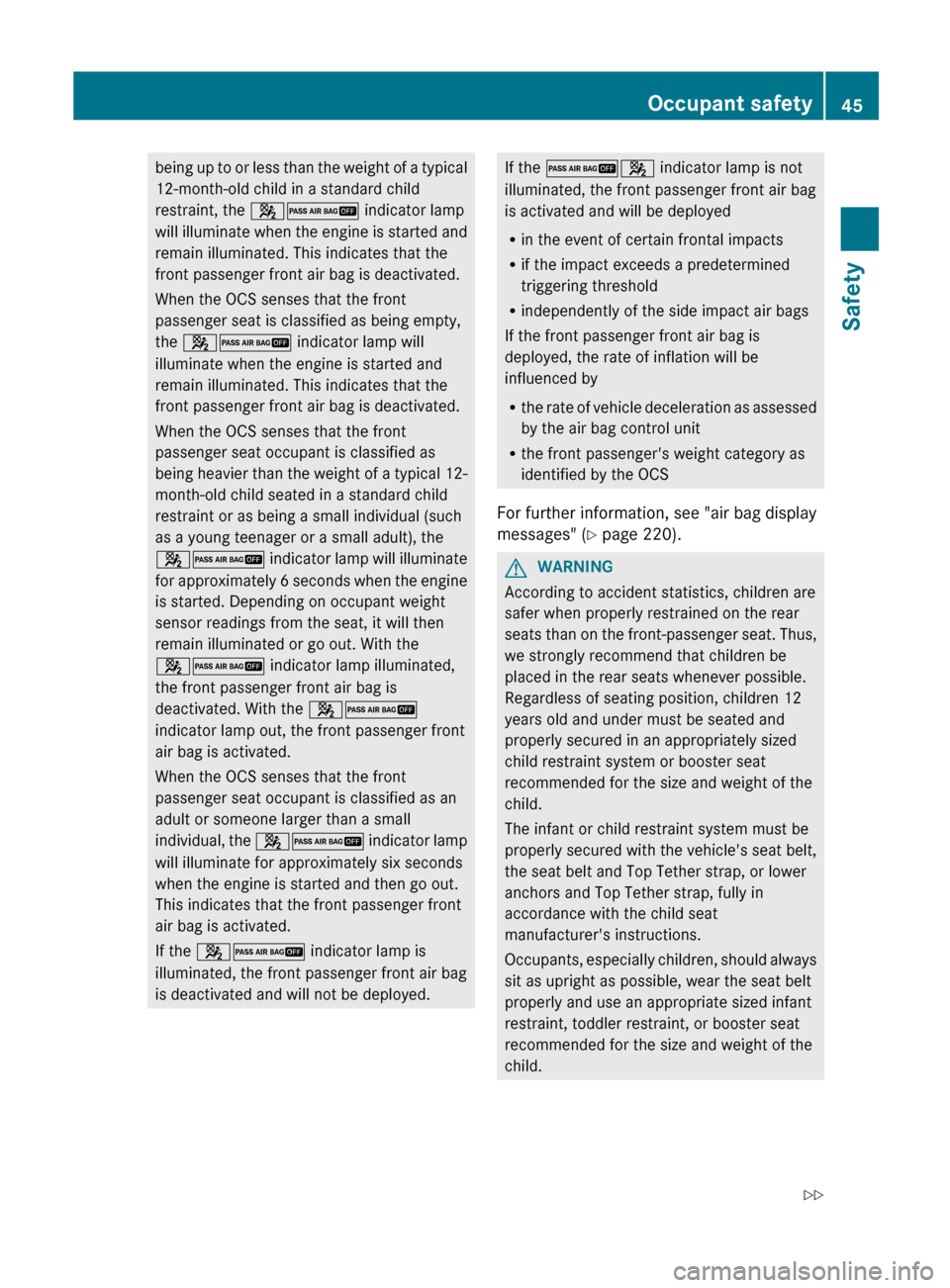
being up to or less than the weight of a typical
12-month-old child in a standard child
restraint, the 42 indicator lamp
will illuminate when the engine is started and
remain illuminated. This indicates that the
front passenger front air bag is deactivated.
When the OCS senses that the front
passenger seat is classified as being empty,
the 42 indicator lamp will
illuminate when the engine is started and
remain illuminated. This indicates that the
front passenger front air bag is deactivated.
When the OCS senses that the front
passenger seat occupant is classified as
being heavier than the weight of a typical 12-
month-old child seated in a standard child
restraint or as being a small individual (such
as a young teenager or a small adult), the
42 indicator lamp will illuminate
for approximately 6 seconds when the engine
is started. Depending on occupant weight
sensor readings from the seat, it will then
remain illuminated or go out. With the
42 indicator lamp illuminated,
the front passenger front air bag is
deactivated. With the 42
indicator lamp out, the front passenger front
air bag is activated.
When the OCS senses that the front
passenger seat occupant is classified as an
adult or someone larger than a small
individual, the 42 indicator lamp
will illuminate for approximately six seconds
when the engine is started and then go out.
This indicates that the front passenger front
air bag is activated.
If the 42 indicator lamp is
illuminated, the front passenger front air bag
is deactivated and will not be deployed.If the 24 indicator lamp is not
illuminated, the front passenger front air bag
is activated and will be deployed
R in the event of certain frontal impacts
R if the impact exceeds a predetermined
triggering threshold
R independently of the side impact air bags
If the front passenger front air bag is
deployed, the rate of inflation will be
influenced by
R the rate of vehicle deceleration as assessed
by the air bag control unit
R the front passenger's weight category as
identified by the OCS
For further information, see "air bag display
messages" ( Y page 220).GWARNING
According to accident statistics, children are
safer when properly restrained on the rear
seats than on the front-passenger seat. Thus,
we strongly recommend that children be
placed in the rear seats whenever possible.
Regardless of seating position, children 12
years old and under must be seated and
properly secured in an appropriately sized
child restraint system or booster seat
recommended for the size and weight of the
child.
The infant or child restraint system must be
properly secured with the vehicle's seat belt,
the seat belt and Top Tether strap, or lower
anchors and Top Tether strap, fully in
accordance with the child seat
manufacturer's instructions.
Occupants, especially children, should always
sit as upright as possible, wear the seat belt
properly and use an appropriate sized infant
restraint, toddler restraint, or booster seat
recommended for the size and weight of the
child.
Occupant safety45SafetyZ
Page 113 of 368

Rthe exterior mirrors fold in automatically as
soon as you lock the vehicle from the
outside.
R the exterior mirrors fold out again
automatically as soon as you unlock the
vehicle and then open the driver's or front-
passenger door.
i The mirrors do not fold out if they have
been folded in manually.
Exterior mirror out of position
If an exterior mirror has been pushed out of
position, proceed as follows:
XVehicles without electrically folding
exterior mirrors: move the exterior mirror
into the correct position manually.XVehicles with electronically folding
mirrors: press the mirror-folding button
( Y page 110) repeatedly until you hear the
mirror engage in position.
The mirror housing is engaged again and
you can adjust the exterior mirrors as usual
( Y page 110).
Automatic anti-glare mirrors
GWARNING
If incident light from headlamps is prevented
from striking the sensor in the rear-view
mirror, for instance, by luggage piled too high
in the vehicle, the mirror's automatic anti-
glare function will not operate.
Incident light could then blind you. This may
distract you from the traffic conditions and,
as a result, you may cause an accident.
The rear-view mirror and the exterior mirror
on the driver's side automatically go into anti-
glare mode if the ignition is switched on and
incident light from headlamps strikes the
sensor in the rear-view mirror.
The mirrors do not go into anti-glare mode if
reverse gear is engaged or the interior lighting
is switched on.
Parking position for the exterior
mirror on the front-passenger side
Setting and storing the parking position
You can position the front-passenger side
exterior mirror in such a way that you can see
the rear wheel on that side as soon as you
engage reverse gear. You can store this
position.
XMake sure that the vehicle is stationary and
that the SmartKey is in position 2 in the
ignition lock.XPress button ; for the exterior mirror on
the front-passenger side.XEngage reverse gear.
The exterior mirror on the front-passenger
side moves to the preset parking position.XUse adjustment button : to adjust the
exterior mirror to a position that allows you
to see the rear wheel and the curb.
The parking position is stored.
i If you shift the transmission to another
position, the exterior mirror on the front-
passenger side returns to the driving
position.
Mirrors111Seats, steering wheel and mirrorsZ